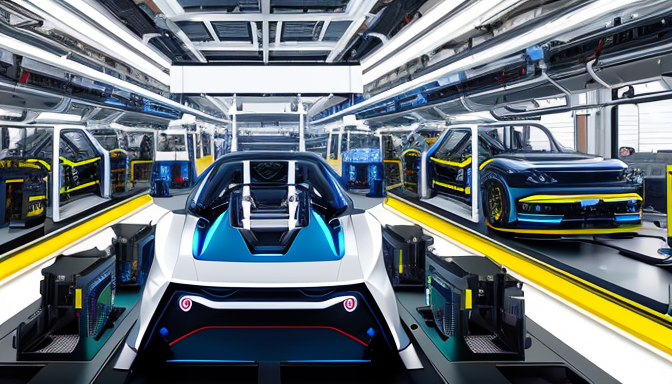In today’s fast-paced world, artificial intelligence (AI) is not just a buzzword; it’s a game changer in the automotive industry. Imagine your car not just being a mode of transport, but a smart companion that learns your habits, predicts your needs, and even keeps you safe. This is not science fiction—it’s happening right now! AI is paving the way for innovations that enhance driving experiences, making them safer and more efficient.
One of the most exciting advancements is the development of AI driving systems. These systems utilize complex algorithms and machine learning to analyze real-time data from various sensors, allowing vehicles to make split-second decisions. For instance, if a pedestrian suddenly steps onto the road, an AI-driven vehicle can react faster than a human driver, significantly reducing the chances of accidents. Isn’t that amazing?
Moreover, the integration of smart features in cars is revolutionizing how we interact with our vehicles. Think about voice-activated controls, personalized dashboard settings, and even predictive maintenance alerts that inform you when your car needs servicing. All these features not only enhance the user experience but also contribute to overall vehicle efficiency.
As we look to the future, it’s clear that AI will continue to drive the automotive industry forward, leading us into a realm of possibilities that were once unimaginable. With advancements in futuristic concepts like autonomous vehicles and smart traffic systems on the horizon, the road ahead is indeed thrilling!
AI-Driven Safety Features
When it comes to the automotive industry, safety has always been a top priority, but with the advent of artificial intelligence, we’re witnessing a revolution like never before. Imagine a world where your car can predict potential hazards before you even see them! AI technologies are enhancing vehicle safety through advanced driver-assistance systems (ADAS), which include features like automatic emergency braking, lane-keeping assist, and adaptive cruise control. These systems work tirelessly in the background, analyzing data from various sensors to keep drivers and passengers safe.
But that’s not all! With the help of predictive analytics, AI can forecast potential accidents by studying traffic patterns and driver behavior. For instance, if the system detects erratic driving patterns, it can alert the driver or even take corrective actions. This is akin to having a co-pilot who’s always on alert, ready to step in when things get dicey. The result? A significant reduction in accident rates and improved overall road safety.
Moreover, real-time monitoring of vehicle performance is another game-changer. AI systems can continuously assess the condition of critical components, alerting drivers to maintenance needs before they become serious issues. This proactive approach not only enhances safety but also extends the life of the vehicle. In summary, with AI at the wheel, we’re not just dreaming of safer roads; we’re driving towards a future where safety is embedded in every journey.

Enhancing Manufacturing Efficiency
In the fast-paced world of automotive manufacturing, artificial intelligence is playing a pivotal role in reshaping how vehicles are built. Imagine a factory where machines not only follow instructions but also learn from past experiences to optimize production processes. This is no longer science fiction; it’s the reality of AI-driven manufacturing. By integrating AI technologies, automotive companies are achieving unprecedented levels of efficiency, reducing waste, and cutting costs.
One of the most significant advancements is in predictive maintenance. AI algorithms analyze data from machinery to predict when a component is likely to fail. This proactive approach helps manufacturers avoid costly downtime, ensuring that production lines run smoothly and vehicles are delivered on time. Additionally, AI enhances supply chain management by forecasting demand and optimizing inventory levels, which leads to a more streamlined production process.
Furthermore, AI-driven robotics are revolutionizing assembly lines. These smart machines can adapt to different tasks, significantly speeding up the manufacturing process. For instance, a robotic arm can switch from assembling one model to another in a matter of minutes, a flexibility that traditional robots lack. This adaptability not only boosts productivity but also allows manufacturers to respond quickly to changing consumer preferences.
In summary, the integration of AI in automotive manufacturing is not just about keeping up with technology; it’s about transforming the entire industry. As manufacturers embrace these innovations, we can expect to see faster production times, lower costs, and ultimately, a better experience for consumers. The future of automotive manufacturing is here, and it’s smarter than ever!
Frequently Asked Questions
- How does AI improve vehicle safety?
AI enhances vehicle safety through advanced driver-assistance systems (ADAS) that help prevent accidents. These systems use real-time data to monitor surroundings, detect obstacles, and even predict potential hazards, making driving safer for everyone on the road.
- What role does AI play in manufacturing efficiency?
AI streamlines production processes by optimizing supply chains and reducing costs. It analyzes data to predict demand, ensuring that manufacturers can produce vehicles faster and more efficiently, ultimately benefiting both the company and the consumer.
- Can AI personalize the customer experience in the automotive industry?
Absolutely! AI can analyze customer preferences and behaviors, allowing manufacturers to offer tailored recommendations and services. This personalization can enhance the buying experience, making it more enjoyable and relevant for each individual.
- What are the future trends of AI in the automotive industry?
Future trends include increased automation in driving, more sophisticated predictive maintenance, and enhanced connectivity features. As AI continues to evolve, we can expect even smarter vehicles that adapt to our needs and improve overall transportation efficiency.